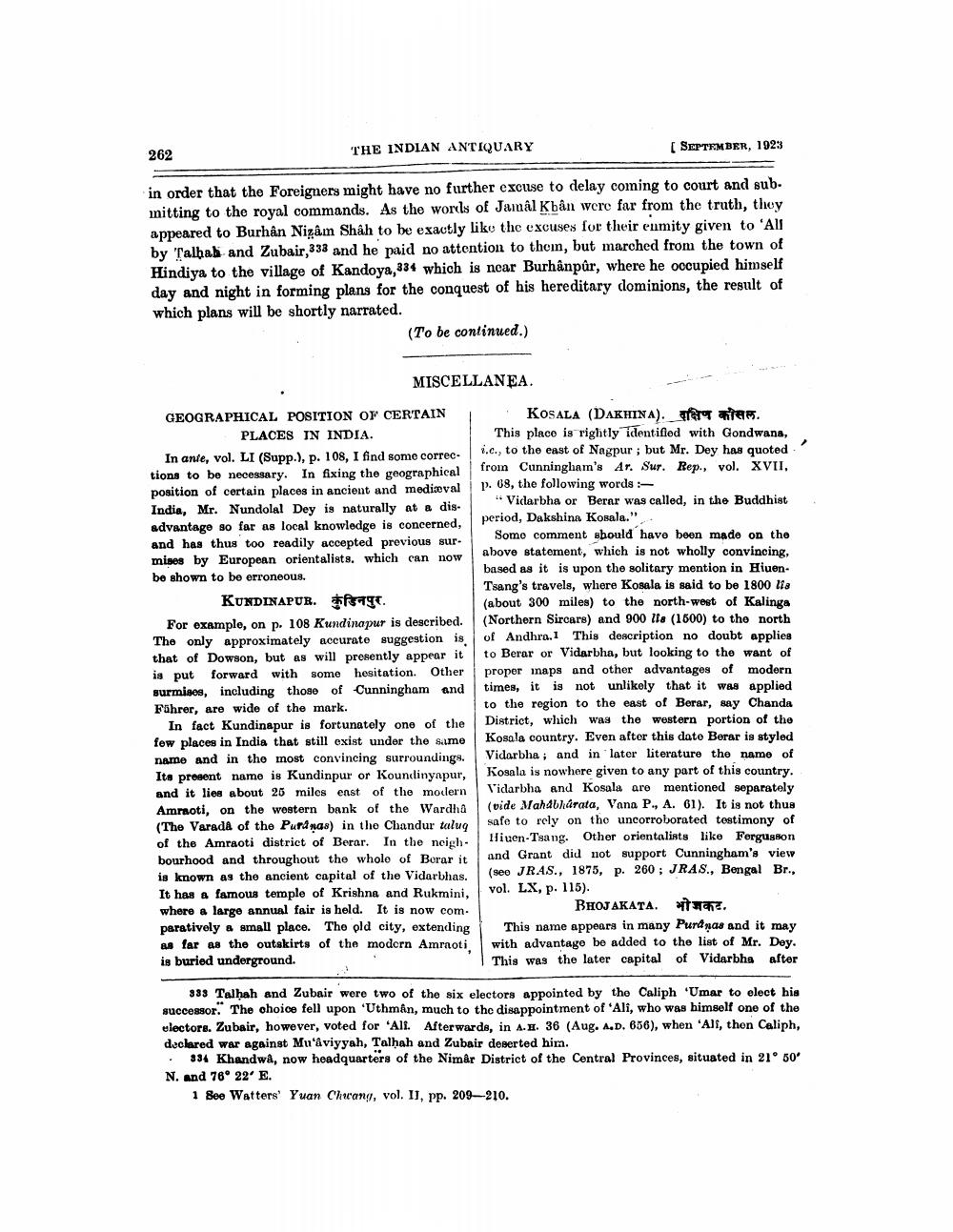________________
262
THE INDIAN ANTIQUARY
( SEPTEMBER, 1923
in order that the Foreigners might have no further excuse to delay coming to court and sub. mitting to the royal commands. As the words of Jamal Kbån were far from the truth, they appeared to Burhân Nizâm Shah to be exactly like the excuses for their enmity given to All by Calhal and Zubair, 333 and he paid no attention to them, but marched from the town of Hindiya to the village of Kandoya,334 which is near Burhanpûr, where he occupied himself day and night in forming plans for the conquest of his hereditary dominions, the result of which plans will be shortly narrated.
(To be continued.)
MISCELLANEA
GEOGRAPHICAL POSITION OF CERTAIN
PLACES IN INDIA. In ante, vol. LI (Supp.), p. 108, I find some corrections to be necessary. In fixing the geographical position of certain places in ancient and medieval India, Mr. Nundolal Dey is naturally at a disadvantage so far as local knowledge is concerned, and has thus too readily accepted previous sur. mises by European orientalists, which can now be shown to be erroneous.
KUNDINAPUR. gr. For examplo, on p. 108 Kundinapur is described. The only approximately accurate suggestion is that of Dowson, but as will presently appear it is put forward with some hesitation. Other surmises, including those of Cunningham and Führer, are wide of the mark.
In fact Kundinapur is fortunately one of the few places in India that still exist under the same name and in the most convincing surroundings. Ito present name is Kundinpur or Koundinyapur, and it lies about 25 miles east of the modern Amraoti, on the western bank of the Wardha (The Varada of the Puranas) in the Chandur talug of the Amraoti district of Berar. In the neighbourhood and throughout the wholo of Borar it is known as the ancient capital of the Vidarbhas. It has a famous templo of Krishna and Rukmini, where a large annual fair is held. It is now com. paratively a small place. The old city, extending w far as the outskirts of the modern Amrnoti is buried underground.
KOSALA (DAKHINA). er ates. This place is rightly identified with Gondwana, i.c., to the east of Nagpur ; but Mr. Dey has quoted from Cunningham's Ar. Sur. Rep., vol. XVII, P. 08, the following words
** Vidarbha or Berar was called, in the Buddhist period, Dakshina Kosala.".
Somo comment should have been made on the above statement, which is not wholly convincing, based as it is upon the solitary mention in Hiuen. Tsang's travels, where Kosala is said to be 1800 lia (about 300 miles) to the north-west of Kalinga (Northern Sircars) and 900 lis (1600) to the north of Andhra. This description no doubt applies to Berar or Vidarbha, but looking to the want of proper maps and other advantages of modern times, it is not unlikely that it was applied to the region to the east of Berar, say Chanda District, which was the western portion of the Kosala country. Even after this date Berar is styled Vidarbha ; and in later literature the name of Kosola is nowhere given to any part of this country. Vidarbha and Kosala are mentioned separately (vide Mahabharata, Vana P., A. 61). It is not thus safe to rely on the uncorroborated tostimony of Hiuen-Tsang. Other orientalists like Ferguson and Grant did not support Cunningham's view (Seo JRAS., 1875, p. 260 ; JRAS., Bengal Br., vol. LX, p. 115).
BHOJAKATA. . This name appears in many Pundnas and it may with advantage be added to the list of Mr. Doy. This was the later capital of Vidarbha altor
383 Talhah and Zubair were two of the six electors appointed by the Caliph 'Umar to elect his successor. The choice fell upon 'Uthman, much to the disappointment of 'Ali, who was himself one of the ulectors. Zubair, however, voted for 'All. Afterwards, in A. 1. 36 (Aug. A.D. 656), when 'Ali, thon Caliph, declared war against Mu'aviyyah, Talhah and Zubair deserted him. • 334 Khandwa, now headquarters of the Nimêr District of the Central Provinces, situated in 21° 50° N. and 76° 22' E.
Bee Watters' Yuan Chwang, vol. II, pp. 209–210.




